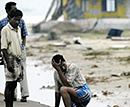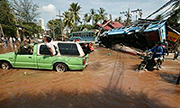|
 Chennai: Over 4,000 people are feared having drowned on the morning of December 26,.2004, when the Bay of Bengal, suddenly and relentlessly roared in to inundate the coastal towns of Tamil Nadu, Pondicherry, Andhra Pradesh and Andaman and Nicobar islands. Chennai: Over 4,000 people are feared having drowned on the morning of December 26,.2004, when the Bay of Bengal, suddenly and relentlessly roared in to inundate the coastal towns of Tamil Nadu, Pondicherry, Andhra Pradesh and Andaman and Nicobar islands.
Human casualties are high in Chennai, Nagapattinam, Kanyakumari, Cuddalore and some other towns in Tamil Nadu. Prakasam district in Andhra Pradesh bore the brunt of the sea's fury that took the lives of several thousands and left several more shocked and homeless. In Kerala, too, coastal districts like Kollam, Allepey and Ernakulam were severely affected by the tidal waves. It all started at 6.30 in the morning, while the world had yet to get over the Yuletide cheer, when Chennai and other towns were awakened by mild tremors (measured at 2 in the Richter Scale). Says Swati Vasan, a 12th Standard student in Chennai, "I was sitting in my bed reading a book when suddenly my cot started shaking and the windows rattling." The tremors were said to be the after-shocks of the severe earthquake that hit the Indonesian island, Sumatra. The earthquake measured 8.9 in the Richter scale - the highest in the last 40 years and fifth strongest since 1900. | The post-Xmas jinx
It was on 26th January 2001, that Gujarat had experienced its worst disaster, an earthquake, that claimed over 20,000 lives and injured around 1.66 lakh. Property damage was estimated around Rs21,262 crore. The shock at 8.46 am and the quake had measured 6.9 on the Richter Scale. Three years later and on the same date, around the same time (8.50 am) but a month earlier (26th December 2004) southern India not only shook but several of its coastal districts were flooded when the sea rushed in killing around 5,000 people. | And in two hours the sea suddenly roared into several southern coastal districts. Tidal waves that rise after an earthquake are called Tsunami and it is the first time a Tsunami has hit an Indian coastal town. Normally on a full moon day the sea will be bit rough. But on the Sunday morning it turned ferocious. According to official estimates, in Chennai around 130 lost their lives. Joggers / walkers, children playing cricket on the Marina beach and the fisherman folk who live on the Santhome Beach and Royapuram area were swallowed by a towering wall of water, which then proceeded to flood the nearby slums. According to a youth in the Marina beach, those who were near the water or lazing on the sand had no chance of escape as a sheet of water came well up to the road, several metres away, tossing an Ambassador car out of its way. The Marina, the second longest beach in the world, after black Sunday, will never be able to live down its sobriquet of a watery grave. "It all happened in a matter of minutes. I just completed repairing my nets and the next moment water gushed in," recalls a fisherman at Thiruvanmiyur beach in Chennai.  Adds hardware vendor Dax Networks Limited's director Deepak Mirza whose house opens on to the beach in Thiruvanmiyur, "I heard a deafening crash. My wife who was watching the sea from the first floor called out saying that the see was coming in." Adds hardware vendor Dax Networks Limited's director Deepak Mirza whose house opens on to the beach in Thiruvanmiyur, "I heard a deafening crash. My wife who was watching the sea from the first floor called out saying that the see was coming in."
At Thiruvanmiyur, the sea was seen playing a tantalising game, luring in people to their death. After gushing in initially, the sea receded to its normal level. And, suddenly it began to recede further and further as if being sucked in by some mighty force back where it came from. With the sea having receded completely leaving behind a long stretch of sand that earlier used to be always submerged, people started moving forward on the exposed stretch of sand. And, suddenly, within minutes the waves rushed back with renewed vigour to reclaim what they had vacated. In panic, the people rushed back to the safety of land, hotly pursued by the sea. Fortunately, no lives were lost. Meanwhile, hundreds of people who have lost their homes in Chennai are now staying in the Chennai Municipal Corporation schools and other buildings. Many also live on the roads with whatever pitiful belongings they could salvage from the water. In Nagapatinam the death toll exceeded 700, in Cuddalore over 300. In Kanyakumari and Pondicherry the loss of lives is estimated to be over 100 and 50 respectively. According to reports, around 700 tourists were stranded in the Vivekananda Rock while rescue efforts are underway. Tamil Nadu chief minister J Jayalalithaa made an ariel survey of the affected areas and visited the two government hospitals in Chennai. She also announced a government grant of Rs1lakh to the survivors' families. Next to Tamil Nadu it is coastal Andhra Pradesh that suffered the most, with over 200 dead. In Kerala over 110 people are believed to have lost their lives in the coastal districts like of Kollam, Allepey and Ernakulam. Similarly in the Andaman and Nicobar Islands around 30 people lost their lives and more than hundred were injured; the islands experienced repeated tremors all day. However, it is the fate of hundreds of fishermen from Tamil Nadu, Andhra Pradesh, Kerala and Pondicherry who were out at sea, that has been a source of anxiety. While prime minister Dr Manmohan Singh personally assured the chief ministers of the four affected states, the crisis management group headed by cabinet secretary B K Chaturvedi has chalked out emergency relief measures to supply medicines, blankets, food and others to the Andaman and Nicobar islands. Islands strongly felt the impact of the Indonesian earthquake in the morning. Another earthquake followed at 9:53 am, measuring 7.3 on the Richter Scale, off Nicobar Island, approximately 60 miles west of Indira point. About 21,000 people in the south of Car Nicobar Island and about 24,000 people in the Great Nicobar Island have been affected. The other affected areas are Kamota, Campbell Bay and Havelock Islands. As a result of the earthquake, the runway at Port Blair airport has suffered some damage. The union health ministry has deputed two 'emergency medical relief teams' for Tamil Nadu, Pondicherry and Andhra Pradesh. Dr. Badhrinath, deputy director general,health, has since the tragedy, arrived in Pondicherry. Meanwhile, the meteorological department has warned of tidal waves and after-shocks, and earthquake during the next two days. As if adding a menacing note to the warning, the sea at Cuddalore had turned turbulent during the day. Asia shaken
The total toll of the post-Xmas black Sunday is estimated to be over 10,000 people across five Asian countries - India, Sri Lanka, Indonesia, Thailand and Maldives. However, the brunt of the damage - loss of lives and property - was in southern India, followed by Sri Lanka. While the death toll in southern India is feared to be over 4,000, in Sri Lanka over 3,000, in Indonesia 4,000 and in Thailand 300. The tidal waves that hit Sri Lanka, freed around 200 jail inmates as the Matara prison was washed away. Even as three of its own states and one union territory were severely affected by the tsunami, the Indian government is sending two ships carrying life saving medicines and other relief materials - food, clothing and water as humanitarian aid - befitting its role as a regional leader. |